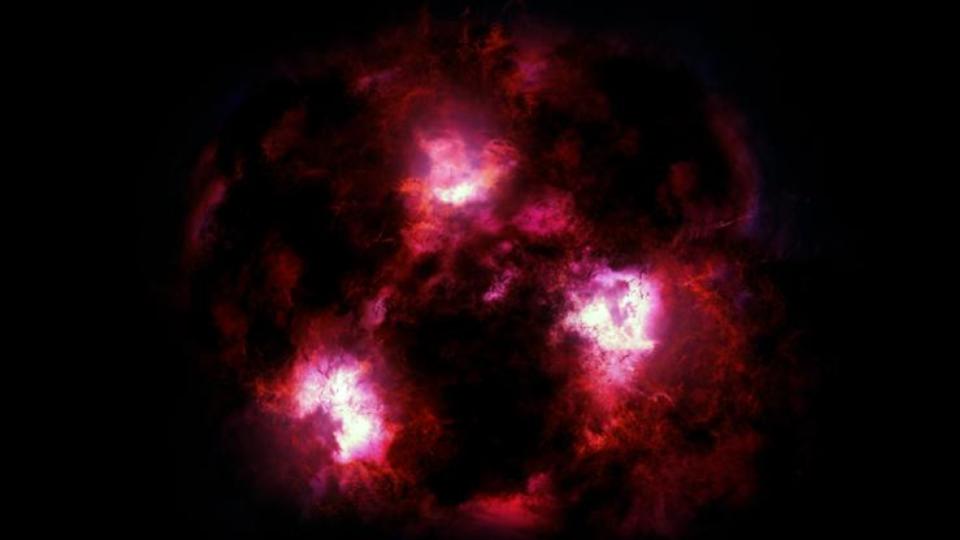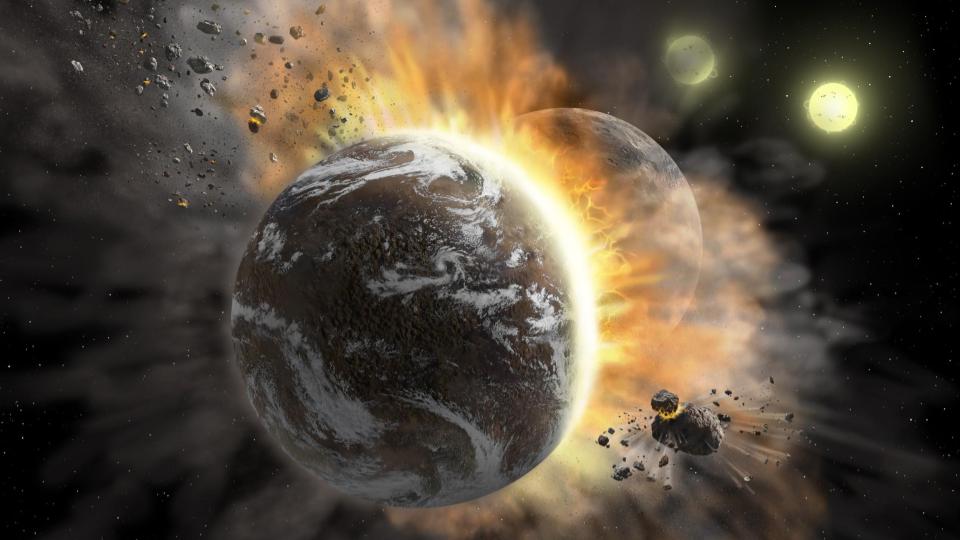New data keeps showing new systems doing unexpected things. In today’s round-up of “that’s unexpected,” we confirm the universe isn’t expanding as expected, that galaxies formed in unexpected ways, and we find unexpected warm dust in a binary star system that may host colliding worlds.
Links
- A Crisis In Cosmology (Press Release)
- Cosmic Yeti from the Dawn of the Universe Found Lurking in Dust (Press Release)
- When Exoplanets Collide (Press Release)

In today’s first story we return to the cosmological constant debacle we’ve been covering for the past few months. Scientists the world over are looking for observational data that will help confirm or deny that the universe has an inexplicably different expansion rate than is predicted from observations of the cosmic microwave background. In the latest paper on this topic, astronomers using the Keck Observatory in Hawaii have observed a series of gravitationally lensed quasars, and used the geometry of the systems to measure the expansion rate of the universe in the modern epoch. In each system, a relatively nearby galaxy bends the light of a background galaxy toward us here on earth. Normally this light would have gone somewhere else entirely, but gravity acts like fun-house mirror, bending distorted light around corners to us. In these systems, multiple versions of the background quasars can be seen, with the light from each version travelling a different distance. Since quasars aren’t constant in their brightness, irregularities in their brightness can be used to time how long it takes light to travel down each different path, with longer paths taking longer periods of time.
The University of California Davis researchers who led the analysis of this data took every possible prevention they could to remove any possible bias in their data reduction process, and found that when they put all the data together, they had a result consistent with earlier measurements for the modern universe, leading credence to the notion that there is something fundamentally flawed in our understanding of how the universe evolved from the Cosmic Microwave Background to the universe we see today. What that something is… well these are the questions that drive astronomers to be astronomers, and to keep building newer, better instruments to use exploring our universe.

In the beginning of the universe, galaxies were supposed to be small. But no one, especially not galaxies, likes to be told what they are supposed to be.
University of Arizona astronomer Christina Williams recently stumbled across an unexpected background signal in images she was taking with the Atacama Large Millimeter Array. This strange shimmering could only be seen in the radio, and appears to come from a truly massive, dust enshrouded galaxy that was already advanced in its formation 12.5 billion years ago.
This surreal object already has as many stars as our Milky Way at this young age, and is forming an additional 100 stars per year, a rate greater than what we in our entire local group! This system appears to be a missing link in the formation story of massive ancient systems, showing that it is possible for some galaxies to form through the singular collapse of a massive amount of dust and gas, as well as through the more common merger of small systems over time.
What isn’t known yet is how common these systems are. This one was found by accident in a small patch of sky, just 1% the size of the moon. It could be that these objects are fairly common, or that Williams team was incredibly lucky. I for one now wish that it was possible to simply survey the sky with ALMA, but with its small field of view and need for so many directed projects, that just isn’t a possibility at this time,

From distant galaxy formation, we now move closer to home, and look at the evolution of planetary systems. About 10 years ago, scientists noticed that a disk of material in the binary system BD +20 307 was significantly warmer than expected. When star systems form, they are hot chaotic places, but over time, as the stars settle down and the planets settle into quiet orbits, things literally cool down in temperature. Funding a warm disc of material in a system that was already a billion years old seemed to indicate that this system had undergone something violent enough to heat things up.
Now, astronomers using the SOFIA airboard observatory have discovered that the system is 10% warmer than it was 10 years ago – I sign that there is even more warm dust now than there was then! The best explanation for this system is that two worlds recently collided, and the hot debris they created, with the energy of the collision going in part into heat, is what is appearing in these images.
While there could be other explanations for what we’re seeing, this story is currently the best fit model, and this system is one that we’re going to watching into the future.
That rounds out our show for today.
Thank you all for listening. The Daily Space is produced by Susie Murph, and is a product of the Planetary Science Institute, a 501(c)3 non profit dedicated to exploring our Solar System and beyond. We are made possible through the generous contributions of people like you. If you would like to learn more, please check us out on patreon.com/cosmoquestx
Each live episode of the Daily Space is archived on YouTube. If you miss an episode here on Twitch.tv, you can find it later on youtube.com/c/cosmoquest. These episodes are edited and produced by Susie Murph.
We are here thanks to the generous contributions of people like you who allow us to pay our staff a living wage. Every bit, every sub, and every dollar committed on Patreon.com/cosmoquestx really helps. If you can’t give financially, we really do understand, and there are other ways you can help our programs. Right now, the best way you can help is to get the word out. Let you friends know, share our channel to your social media, or leave a recommendation. You never know what doors you are opening.


 We record most shows live, on Twitch. Follow us today to get alerts when we go live.
We record most shows live, on Twitch. Follow us today to get alerts when we go live.